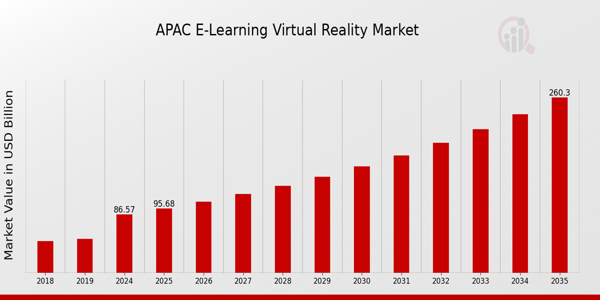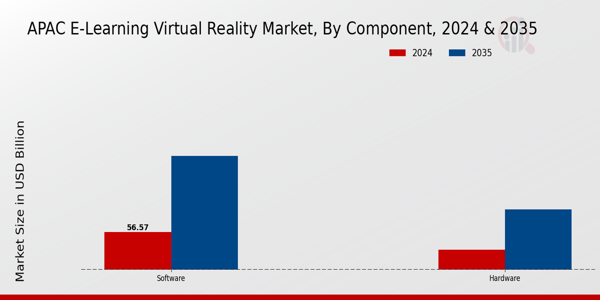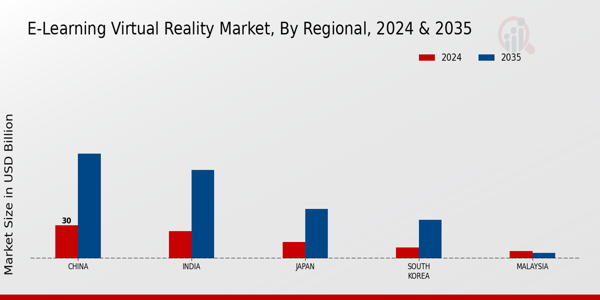APAC E-Learning Virtual Reality Market Overview
As per MRFR analysis, the APAC E-Learning Virtual Reality Market Size was estimated at 79.21 (USD Billion) in 2023.The APAC E-Learning Virtual Reality Market is expected to grow from 86.57(USD Billion) in 2024 to 260.3 (USD Billion) by 2035. The APAC E-Learning Virtual Reality Market CAGR (growth rate) is expected to be around 10.526% during the forecast period (2025 - 2035).
Key APAC E-Learning Virtual Reality Market Trends Highlighted
The APAC E-Learning Virtual Reality Market is experiencing significant growth, driven by a variety of key market drivers. One major factor is the increasing adoption of advanced technologies in education, which is supported by regional governments that are actively promoting digital learning initiatives. Countries like Singapore and South Korea are leading the charge by integrating virtual reality into their educational frameworks, enhancing engagement and knowledge retention among students.
The growing focus on personalized learning experiences has also fueled interest in virtual reality solutions, as they allow educators to create customized learning environments tailored to individual student needs.There are many chances to be taken in the APAC E-Learning Virtual Reality Market. As businesses and schools try to stand out, there is a chance for technology companies and content creators to work together to make high-quality, immersive educational content.
Also, there is a growing need for vocational training that uses virtual reality. This shows that many industries in the area need to improve their practical skills. This makes it possible to create targeted VR training programs that can improve job readiness and the skills of the workforce. Recent trends show that there is a clear move toward blended learning models, which combine traditional teaching methods with virtual reality experiences.
Schools and universities are increasingly integrating VR into their curricula, offering students unique opportunities to explore complex subjects interactively. Moreover, with the rise of online learning due to the pandemic, there has been a surge in interest in VR applications that can create engaging remote learning experiences. This trend, combined with the advancement in VR technology, is set to redefine the educational landscape in APAC, ensuring that learning continues to evolve alongside technological innovations.

Source: Primary Research, Secondary Research, Market Research Future Database, and Analyst Review
APAC E-Learning Virtual Reality Market Drivers
Growing Adoption of Technological Advancements in Education
The APAC E-Learning Virtual Reality Market is witnessing significant growth due to the increasing adoption of advanced technologies in education. Governments and educational institutions across countries like India, China, and Japan are integrating Artificial Intelligence, Virtual Reality, and Augmented Reality into their e-learning platforms.
The Ministry of Education in China announced investments of over 100 billion USD towards digital education infrastructures, emphasizing the positive trend towards immersive learning experiences.Such initiatives enhance engagement and retention rates among students, helping the APAC E-Learning Virtual Reality Market grow further as more institutions adapt to these technologies.
Reports also indicate that students retain information 75% more effectively when learning through immersive experiences compared to traditional methods, highlighting the market's promising trajectory.
Rising Demand for Remote Learning Solutions
The COVID-19 pandemic has accelerated the need for remote learning solutions across the APAC region. As educational institutions transitioned to online platforms, the demand for Virtual Reality e-learning solutions surged, providing students with interactive and engaging learning environments from their homes. Various reports show that online educational platforms in APAClike Coursera and EdX, have seen enrollment rise by over 200% since 2020.
Furthermore, the implementation of government policies, such as India's National Education Policy, which promotes technology-integrated learning, is fostering growth in this sector.This increased reliance on remote learning solutions is a key driver in the expansion of the APAC E-Learning Virtual Reality Market.
Enhancement of Skill Development Programs
In the APAC region, there is a significant focus on enhancing skill development through advanced training programs that leverage e-learning and Virtual Reality technologies. Organizations like the Singapore Economic Development Board have reported a strong push for upskilling initiatives aimed at improving workforce capabilities.
By 2025, it is projected that over 1 million workers in Singapore will need to undergo reskilling, with virtual training programs playing a crucial role in this transition.This emphasis on skill development is leading to an increased need for e-learning platforms utilizing Virtual Reality, thus driving growth in the APAC E-Learning Virtual Reality Market.
Investment in E-learning Startups and Innovations
The APAC E-Learning Virtual Reality Market is also experiencing an influx of investment in startups that specialize in innovative educational technologies. For instance, recent funding rounds for companies like Byju's in India, which raised approximately 1 billion USD, highlight the financial backing available to firms pioneering in this sector.
The growth of these startups is fueled by the demand for cutting-edge e-learning solutions, which are increasingly seen as essential in a competitive education market.This surge in investments is expected to enhance product offerings, thereby fostering further adoption of Virtual Reality in education throughout the APAC region.
APAC E-Learning Virtual Reality Market Segment Insights
E-Learning Virtual Reality Market Component Insights
The APAC E-Learning Virtual Reality Market is experiencing a notable transformation, primarily driven by the increasing integration of advanced technologies into educational frameworks, with the Component segment comprising critical elements such as Hardware and Software. The importance of the Hardware aspect is underscored by its essential role in delivering immersive learning experiences, as virtual reality headsets, sensors, and other devices facilitate a hands-on approach to education.
This hardware segment is expected to see significant demand from educational institutions seeking to enhance student engagement and comprehension through interactive technologies. Meanwhile, the Software components drive the educational content and user interfaces that are crucial for delivering effective virtual reality experiences.
This software segment is characterized by its ability to provide developers with tools to create diverse educational modules, ranging from simulations of complex scientific processes to language learning environments, thus catering to a wide array of learning styles. In the APAC region, the shift towards remote and blended learning environments has been accelerated by recent global events, pushing educational institutions to explore innovative methods of instruction, including the utilization of virtual reality technology.
Countries like Japan and South Korea are at the forefront, investing heavily in E-Learning initiatives, thereby enhancing the demand within the APAC E-Learning Virtual Reality Market. Furthermore, with the growing recognition of the efficacy of experiential learning, educational content developers are increasingly adapting to virtual reality platforms, leading to a proliferation of learning applications that utilize these components effectively. The region's advancements in connectivity and digital infrastructure also drive the market, facilitating widespread access to these educational tools.
Challenges remain in terms of initial investment costs and the need for training educators in the use of these technologies, although the benefits of improved learning outcomes and retention rates provide a strong incentive for adoption. As educational institutions continue to recognize the value in immersive learning, both Hardware and Software segments will likely play pivotal roles in shaping the future of education in APAC, driving further growth and innovation within the APAC E-Learning Virtual Reality Market, both in practice and in potential academic outcomes.

Source: Primary Research, Secondary Research, Market Research Future Database, and Analyst Review
E-Learning Virtual Reality Market Technology Insights
The APAC E-Learning Virtual Reality Market is experiencing a transformative phase, driven significantly by advancements in Technology. The market comprises two main categories, Non-Immersive and Fully Immersive experiences, each catering to diverse learning needs. Non-Immersive solutions leverage existing devices and platforms, making these tools widely accessible for users. This approach is valuable for enhancing traditional learning experiences without the need for expensive gear.
Conversely, Fully Immersive experiences provide users with engaging and interactive environments that mimic real-world scenarios.This level of immersion promotes higher retention rates and user engagement, particularly beneficial in training and simulation-based education. The rising smartphone penetration and increased internet accessibility across the APAC region have catalyzed the adoption of both types, enabling educators and organizations to effectively implement immersive learning methods within their curriculums.
With governments and educational institutions increasingly investing in digital learning infrastructures and policy frameworks, the APAC E-Learning Virtual Reality Market is steadily reshaping educational landscapes while accommodating new modalities of teaching and learning.Overall, both segments play crucial roles in defining the future of education in the region, positioning themselves as key contributors to the market's growth trajectory.
E-Learning Virtual Reality Market Application Insights
The APAC E-Learning Virtual Reality Market is experiencing transformative growth, particularly within the Application segment, which encompasses various educational avenues. As organizations and educational institutions increasingly adopt virtual reality technologies, the market is witnessing significant projects aiming to enhance the learning experience. The Academic sector leverages immersive environments to stimulate student engagement and facilitate experiential learning.
This approach is especially relevant in STEM education, where visualizing complex concepts can greatly improve comprehension.Meanwhile, the Corporate sector focuses on training and development, utilizing virtual simulations to develop skills in a risk-free environment. Such applications not only accelerate learning processes but also reduce the costs associated with traditional training methods. The expanding digital landscape in APAC, driven by increasing internet penetration and smartphone usage, further propels the demand for innovative e-learning solutions.
Moreover, government initiatives promoting digital literacy act as a catalyst, urging educational institutions and businesses to adopt advanced technological frameworks.This collective progress underscores the vital role of the Application segment in shaping the future of education and corporate training within the APAC region. The integration of virtual reality into e-learning aligns with the regional trend towards modernization and digital transformation.
E-Learning Virtual Reality Market Regional Insights
The Regional segment of the APAC E-Learning Virtual Reality Market showcases a dynamic growth pattern, influenced significantly by various local factors and advancements in technology. In China, this sector is propelled by a robust demand for innovative educational tools, where education technology is seen as a priority for national development. India represents a rapidly expanding market, as rising internet penetration and an increasing focus on upskilling drive interest in virtual learning solutions.
Japan, known for its technological advancements, emphasizes integrating virtual reality in education to enhance student engagement and learning outcomes.South Korea also contributes with a strong emphasis on education and technology, allowing for a fusion of traditional learning methods with cutting-edge VR solutions. Malaysia and Thailand are emerging players in this segment, focusing on customized e-learning solutions to meet their specific educational needs.
Indonesia, with its growing youth population, is gradually adopting virtual reality in learning environments to cater to diverse learning styles. The Rest of APAC is characterized by varied adoption rates and strategies, reflecting each country’s unique cultural and educational priorities.The APAC E-Learning Virtual Reality Market benefits from a blend of opportunities to enhance educational experiences, making it a crucial focus for stakeholders aiming to invest in innovative learning within this region.

Source: Primary Research, Secondary Research, Market Research Future Database, and Analyst Review
APAC E-Learning Virtual Reality Market Key Players and Competitive Insights
The APAC E-Learning Virtual Reality Market is experiencing significant growth as educational institutions and corporate trainers increasingly recognize the value of immersive learning experiences. This segment of the education technology market is characterized by rapid technological advancements, changing consumer expectations, and an escalating interest in personalized learning solutions. Key players in this market are leveraging innovative approaches to create immersive environments that enhance learner engagement, retention, and overall educational outcomes.
The competitive landscape is marked by a combination of established education technology providers and agile newcomers, fueling intense competition and collaboration through strategic partnerships, new product developments, and targeted regional expansions. The dynamic nature of this market provides a robust platform for exploring modern pedagogies and leveraging virtual reality technologies to redefine traditional education frameworks.
Blackboard maintains a formidable presence in the APAC E-Learning Virtual Reality Market, primarily through its versatile platforms that cater to a diverse range of educational institutions. The company's strengths lie in its comprehensive suite of products designed to enhance learning experiences, including its Virtual Learning Environment, which integrates VR technologies for more immersive content delivery.
Blackboard has successfully built partnerships with regional educational institutions to foster the adoption of these technologies, helping them to customize learning pathways and increase student engagement. By focusing on user-friendly interfaces and robust support systems, Blackboard has managed to cultivate significant trust among educators and learners in the region.
Its ongoing commitment to innovation positions the company as a prominent player in the evolving landscape of e-learning.Tencent is another key competitor in the APAC E-Learning Virtual Reality Market, boasting a strong portfolio of products and services tailored to enhance educational experiences through its digital ecosystem. The company's extensive range of platforms, including its popular communication and collaborative tools, integrates well with virtual reality applications aimed at enhancing learning outcomes.
Tencent's strengths are bolstered by its substantial financial resources and technological expertise, allowing it to invest in research and development to create next-generation VR educational solutions. The company's commitment to enhancing its product offerings through mergers and acquisitions has enabled it to expand its influence and market presence in the APAC region, making significant strides in partnerships with educational institutions and content providers. As Tencent continues to innovate and deliver immersive educational experiences, it solidifies its position as a significant player in the competitive e-learning landscape.
Key Companies in the APAC E-Learning Virtual Reality Market Include
- Blackboard
- Tencent
- Udacity
- VictoryXR
- ClassVR
- EON Reality
- Immerse
- Coursera
- Edmodo
- Skillsoft
- Pixaera
- Alibaba Group
- Zovio
- Google
- VR Education Holdings
APAC E-Learning Virtual Reality Market Developments
The APAC E-Learning Virtual Reality Market has witnessed significant developments recently. In September 2023, Blackboard expanded its capabilities in the region, integrating advanced VR technology to enhance user engagement in its learning platforms. Tencent, in August 2023, announced increased investment in immersive education solutions, focusing on VR content creation for K-12 schools.
Meanwhile, Udacity launched a VR-based course specifically targeting software development skills in July 2023. VictoryXR gained recognition in June 2023 for its innovative use of VR in educational simulations, catering to higher education institutions across the APAC region. In terms of mergers and acquisitions, ClassVR acquired a local VR company in April 2023 to bolster its offerings in the Asian market, while EON Reality is also reported to be exploring partnerships with local firms for content development.
The market valuation for companies like Skillsoft and Alibaba Group has significantly increased over the past few years, driven by the growing adoption of VR in educational frameworks. Such growth is positively impacting the APAC E-Learning Virtual Reality Market, particularly in response to increasing demand for immersive learning experiences across various education sectors.
APAC E-Learning Virtual Reality Market Segmentation Insights
-
E-Learning Virtual Reality Market Component Outlook
-
E-Learning Virtual Reality Market Technology Outlook
- Non-Immersive
- Fully Immersive
-
E-Learning Virtual Reality Market Application Outlook
-
E-Learning Virtual Reality Market Regional Outlook
- China
- India
- Japan
- South Korea
- Malaysia
- Thailand
- Indonesia
- Rest of APAC
| Report Attribute/Metric Source: |
Details |
| MARKET SIZE 2023 |
79.21(USD Billion) |
| MARKET SIZE 2024 |
86.57(USD Billion) |
| MARKET SIZE 2035 |
260.3(USD Billion) |
| COMPOUND ANNUAL GROWTH RATE (CAGR) |
10.526% (2025 - 2035) |
| REPORT COVERAGE |
Revenue Forecast, Competitive Landscape, Growth Factors, and Trends |
| BASE YEAR |
2024 |
| MARKET FORECAST PERIOD |
2025 - 2035 |
| HISTORICAL DATA |
2019 - 2024 |
| MARKET FORECAST UNITS |
USD Billion |
| KEY COMPANIES PROFILED |
Blackboard, Tencent, Udacity, VictoryXR, ClassVR, EON Reality, Immerse, Coursera, Edmodo, Skillsoft, Pixaera, Alibaba Group, Zovio, Google, VR Education Holdings |
| SEGMENTS COVERED |
Component, Technology, Application, Regional |
| KEY MARKET OPPORTUNITIES |
Increased adoption of immersive technologies, Growing demand for remote learning solutions, Enhancement of student engagement levels, Expansion of corporate training programs, Collaboration with gaming companies |
| KEY MARKET DYNAMICS |
growing demand for immersive learning, increasing adoption of VR technology, rising investment in EdTech, need for remote education solutions, collaboration with educational institutions |
| COUNTRIES COVERED |
China, India, Japan, South Korea, Malaysia, Thailand, Indonesia, Rest of APAC |
Frequently Asked Questions (FAQ):
The APAC E-Learning Virtual Reality Market is expected to be valued at 86.57 billion USD in 2024.
By 2035, the APAC E-Learning Virtual Reality Market is anticipated to reach a valuation of 260.3 billion USD.
The market is expected to grow at a CAGR of 10.526% from 2025 to 2035.
China is expected to hold the largest market share, with projected values of 30.0 billion USD in 2024 and 95.0 billion USD in 2035.
The market size in India is projected to be 25.0 billion USD in 2024.
Major players include Blackboard, Tencent, Udacity, and Coursera among others.
The Software component is valued at 56.57 billion USD in 2024.
The Hardware component is expected to reach 90.0 billion USD by 2035.
The market is likely to face challenges such as infrastructure limitations while presenting opportunities through enhanced learning experiences.
Japan is projected to grow from 15.0 billion USD in 2024 to 45.0 billion USD by 2035.

















